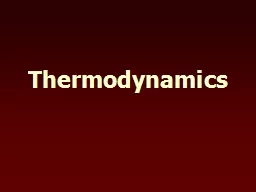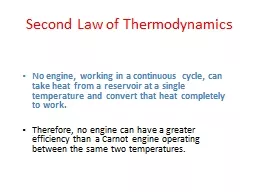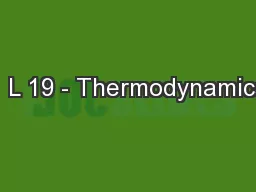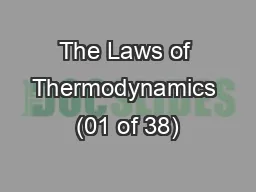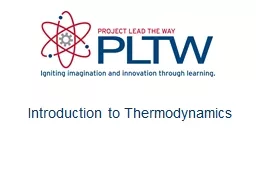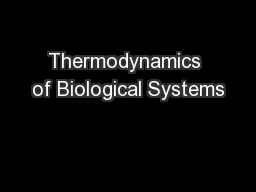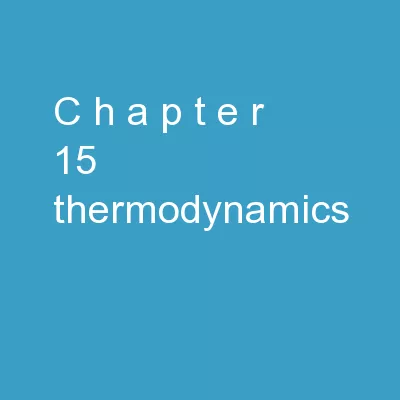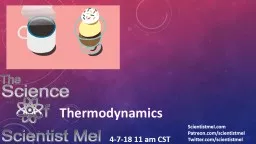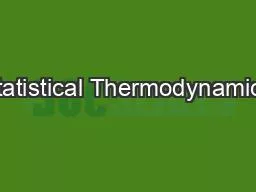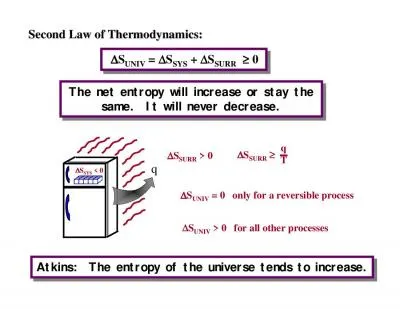PPT-L 17 - Thermodynamics [2]
Author : alexa-scheidler | Published Date : 2018-02-28
Todays topics Practical thermal effects Devices for temperature measurement Mechanisms of heat transfer Science dealing with the relationship between thermal energy
Presentation Embed Code
Download Presentation
Download Presentation The PPT/PDF document "L 17 - Thermodynamics [2]" is the property of its rightful owner. Permission is granted to download and print the materials on this website for personal, non-commercial use only, and to display it on your personal computer provided you do not modify the materials and that you retain all copyright notices contained in the materials. By downloading content from our website, you accept the terms of this agreement.
L 17 - Thermodynamics [2]: Transcript
Todays topics Practical thermal effects Devices for temperature measurement Mechanisms of heat transfer Science dealing with the relationship between thermal energy random molecular motion. LIMITATION OF FIRST LAW OF . THERMODYNAMICS. It does not give information concerning feasibility of a thermodynamic . proces. .. why. NOT EXPLAINED BY FIRST LAW. It tells that work obtained is equal to heat absorbed but in actual heat absorbed can not be completely converted into work. 1. st. law of thermodynamics. Energy may be converted to different forms, but it is neither created nor destroyed during transformations. Energy from chemical bonds is converted to kinetic energy and heat (body and friction from tires). No engine, working in a continuous cycle, can take heat from a reservoir at a single temperature and convert that heat completely to work.. Therefore, no engine can have a greater efficiency than a Carnot engine operating between the same two temperatures.. [4]. Change of phase . . ice. . . water. . steam. The Laws of Thermodynamics. The 1. st. Law. The 2. nd. Law. Applications. Heat engines. Refrigerators. Order to disorder. 2. Change of . Physics Lecture Notes. The Laws of Thermodynamics. FOUNDRY: It requires about 289 Joules of heat to melt one gram of steel. In this chapter, we will define the quantity of heat to raise the temperature and to change the phase of a substance. . Thermodynamics. Rub your hands together for 15 seconds.. Are your hands warm?. Thermal energy. Thermodynamics. The study of the effects of work, heat flow, and energy on a system. Movement of thermal energy. with the emphasis here on large-scale helium cryogenics. Tom . Peterson, SLAC . January 2017. January, 2017 USPAS. Thermodynamics for Cryogenics Tom Peterson. 2. Outline. Definitions . Perfect gas (. Entropy: Criteria for Spontaneity. Second Law of Thermodynamics. Third Law of Thermodynamics. Free Energy . Coupled Reactions. Thermodynamics. The chemistry . that . deals with the flow of energy during a chemical or physical process;. Champion Deivanayagam. Center for Biophysical Sciences and Engineering. University of Alabama at Birmingham.. Outline:. Laws of thermodynamics. Enthalpy. Entropy. Gibbs free energy. some examples. Topics to be covered . Laws of thermodynamics: . Zeroth law, First law, Second law, and Third law. Thermal Processes: . Isobaric, Isochoric, adiabatic, and Isothermal. Heat engines, Refrigerators, Air-conditioners, and Heat pumps. . Patreon.com/. scientistmel. Twitter.com/. scientistmel. 4-7-18 11 am CST. Thermodynamics. Studies the effects on a system. Work. Heat. Energy. System?. System – quantity of matter. Boundaries – fixed or moveable. Topics to be covered . Laws of thermodynamics: . Zeroth law, First law, Second law, and Third law. Thermal Processes: . Isobaric, Isochoric, adiabatic, and Isothermal. Heat engines, Refrigerators, Air-conditioners, and Heat pumps. . – Lecture planning fall term 201 6 * Mondays , 7 :45 - 9 :30 Uhr , HCI J6 ; Tuesdays 7 :45 - 8 :30, lectures HCI J 4, Tutorials HCI D6,E2,E8,F2,F8 Tuesdays 9:45 - 10:30 Tutorial E2 Assistants The net entropy will increase or stay the same It will never decreaseThe net entropy will increase or stay the same It will never decreaseSYSqSx0000 0SqT 0 only for a reversible processx0000 0 f
Download Document
Here is the link to download the presentation.
"L 17 - Thermodynamics [2]"The content belongs to its owner. You may download and print it for personal use, without modification, and keep all copyright notices. By downloading, you agree to these terms.
Related Documents

![PPT-L 17 - Thermodynamics [2]](https://thumbs.docslides.com/639343/l-17-thermodynamics-2.jpg)
